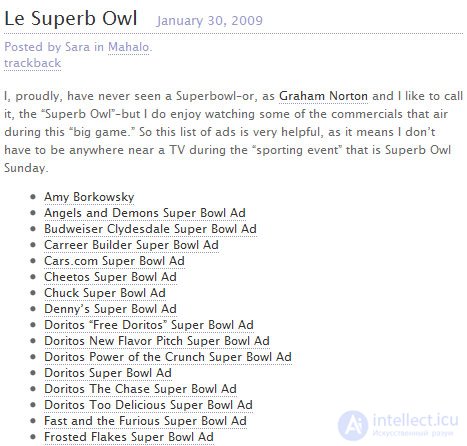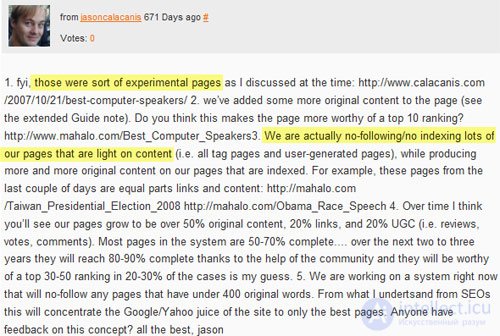Lecture

All shades of gray. Does Google like auto-generated Google AdSense sites? The short answer is no.
The full answer may be more confusing. But as long as they don't ...
... the answer will be - yes, auto-generated sites full of stolen content are suitable for Google Adsense *.
* in terms of Mahalo.com
Development and launch of the project
Before launching the Mahalo project, Jason Calacanas stated that he would be completely spam-free and would become a "death" for SEO experts.
After the project was opened, it was followed by a very intensive content and he continued to assert that Squidoo was spam and continued to call SEO "shit", thereby attracting a lot of attention and of course backlinks.
Such Jyson statements online were well received by the organizers of the SEO conferences, since people are talking about him. Therefore, all conference organizers were built in a queue in order to attract him to their conferences, and where he is, there are people there.
Such a strategy helped Jason to appear in the press and gave a bunch of like-minded bloggers (who needed a competent mentor) in the person of Jason.
A reflection of a misguided public opinion followed on Wikipedia:
Quality of search results
The goal of the Mahalo project is to improve search results by eliminating search spam from low quality sites: those that are clogged with ads, spread malware, or have malicious code found to be 'phishing'. Webmasters have a great desire to check if their site is listed. Calacanis stated that search engines like Google and Yahoo suffer from SEO manipulations. The credibility of the project to moderators (and not robots) will allow to avoid such problems, since such issuance will be more useful for users.
When people steal / lend / syndicate material, publish its original version, and then simply flood the page with advertising, it is generally viewed as spam. But we will come back to this a little later, I promise! ![]()
All the multiple discussions brought the project a huge amount of backlinks, which gave Mahalo a quick start. At first, Jason said that he wanted to create the "best" content for the most popular requests.
But many were misled by the misinformation, as was written in one of the articles cNet - Jason Calacanis' Mahalo: Screw the long tail :
Instead of having a “server economy” that will be great to produce pages for requests that you enter, the Malaho output is created by people waiting for user requests.
How will this work? As Calakanis says, the top 10,000 search queries - 24% of the entire search. If you manage to create high-quality output for these top queries, users will appreciate the full advantage of such a search over the machine, which very often produces low-quality spamming links, and the output of Mahalo is created with love by the moderators. But it is not clear what will happen to the remaining 76% of requests - Mahalo will slip the issue of Google.
At first, the issue was just a list of links, but it was created by man. But such a boring service did not force people to come back and certainly wasn’t worthy of backlinks and discussions. Therefore, it starts using 4 strategies with link building and information content:

Here is what a former Mahalo worker, Matthew Vine Selznick, writes:
As for the Mahalo blog network: I don’t know how old this screenshot is, but it’s funny to see the blogs of people who left the company or were fired in October, when half of the staff (including myself) were cleansed.
...
When I worked for Mahalo, the entire state was very strongly encouraged to blog about Mahalo and those who didn’t have them yet started it up. This gave a significant influx of traffic....
I refused to subscribe to all the blogs of my former colleagues, since most of them turned into tons of links to Mahalo, just like I left blogs that were not interesting.
The content on such blogs, to put it mildly, was not of the best quality, but the strategy worked and they began to bring search traffic.
Despite claims that he only wanted to have some share of the total search volume, this start of traffic extraction did not fit into these words. Even if they poured hundreds of dollars in content, he is not able to bring the system to keywords of very high competition.
For this, it was necessary to add something original or useful, and investing money in writing and promoting content on external resources did not help here.
But despite this, they rather quickly managed to rise on such requests as "best computer speakers" even using low-quality content to promote.
Around this time, I highlighted the use of this strategy. On this occasion, Matt Cutts, the head of Google’s anti-spam department, said Mahalo was okay. Jason Kalakanas uses MediaWiki to create the site.
Jason also made a number of statements about spam, in his commentary on Sphinn: where he said that spam pages are experimental pages that we do not index.
But the screen of his original statement:

That was 671 days ago. What has changed since that time?
Around the time of the incident described above, John Andrews (John Andrew) (who knows SEO like no other) wrote:
Each copied Jason and Mahaloo. Everything looked like a great idea. At first, Jayson publicly humiliated SEO professionals, their goals and everything they do, and a little later he changed his mind. Jason publicly ridiculed everything related to online advertising, and then completely changed his mind on this matter and now we can watch ads on Mahalo. I believe that every site like “How to make money on the Internet quickly” should link to Mahalo with the words “copy them ... they use black SEO methods”. It's very simple, copy. They add pages and splogs, and all this is aimed at getting money. Every time they post a link, you must also link to it. Help Jason build a path to wealth. Every time he makes excuses for his spam - he does it for you too. Every time he explains why he is not a spammer, he does it for you too. And best of all, he will be your representative for free!
Do you think John Andrews is right again? Let's take a look behind the scenes.
That page at the request of "computer speakers", about which we spoke above, is still in the top 5 issue of Google.
The site has grown rapidly and traffic has increased about three times in the last 2 years.

Jason skillfully used the global economic crisis to lay off half the staff. This traffic growth is due to their sophisticated approach to copying content.
To see how their content copying system works, I suggest taking a look at the new page:

If you turn off advertising and do not take into account the copied content - will only navigation and the name of the site - nothing more.
Two more noteworthy things on this page - it is generated by a robot and already indexed by Google . If your domain has high credibility, you can automatically generate pages and rather successfully advance in Google. This is the strategy of Mahalo.

This page (which was automatically generated in less than a minute by the searchclick robot) already occupies a not bad position on Google!
Why do we think searchclick is a robot? Look at the history of last year ... about 10,000 pages created in a minute.
Search engines, like Google, copy content from sites so that it is useful for both the user and the publisher. When they do site snippets - they help to promote it.
Mahalo takes snippets and publishes them as content on its website. So they use the titles of your pages and parts of the content to rank their site without your permission.
If you optimize a new post on your site under the Mahalo machine, then they will copy your page and if your site is less authoritative than Mahalo - they will force you out of the issue!
And in the appendix to everything said - they put the links in the nofollow to the resource where the content is taken from and while they use your content - you don’t even get the links.
No matter how shocked all of the above, but this is only the first step.
What's next - if your content promotes the Mahalo auto page with meaningful keywords, they begin to make more pages in this niche, thereby directing your same content against you - you drop out of the issue until they automatically build a spam empire .

The only reason why employees are involved in this whole thing is to at least somehow legalize the process at this stage. If the company has 200,000+ auto pages with parameters - this is 5 cents per day with each = $ 10,000+ per day!
If you are authoritative enough and have good PR - you will avoid departure from Google.
Those who try to follow Mahalo and spam Google are likely to fail because:
When launching his Mahalo, Jason Kalakanas stated that he would be completely protected from spam and become a "death" for SEO experts. And now, he just simply steals content (putting links to the source in nofollow). Therefore, you lose your search traffic, because a more reputable domain "borrows" your content and displaces it from search engines.
Do you think Twitter is moving in the same direction? Does this mean that those who write content do it to earn others? What can bloggers do if it gets massive?
I do not think that we can convince those people who steal content, but I am very surprised - why does Google close its eyes to this? Maybe this is what they want to turn the Internet into?
Comments
To leave a comment
seo, smo, monetization, basics of internet marketing
Terms: seo, smo, monetization, basics of internet marketing